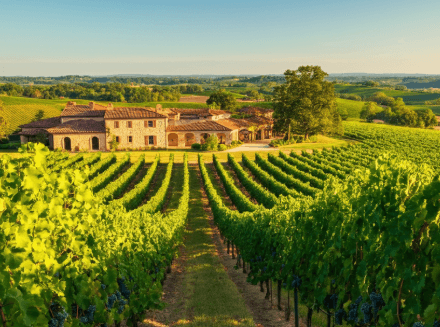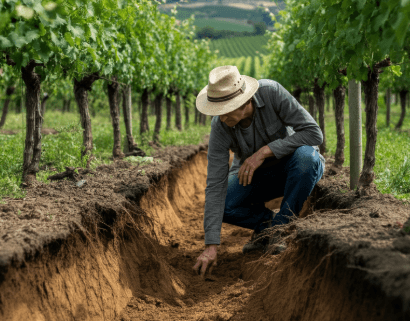Finding the right land for your vineyard or winery can be a game-changer, and it all starts with making informed decisions. Did you know that the cost of vineyard-ready land in areas like Napa can exceed $200,000 per acre, while Sonoma County offers options starting at $70,000 per acre for secondary locations? These figures underscore the importance of making sound choices when buying land for vineyards or wineries. With decades of experience, Steve Daria and Joleigh are not only seasoned real estate investors but also experts in navigating the complexities of land purchases. Whether you’re drawn to prime vineyard locations or are exploring more affordable options, their insights can guide you in making the best investment. They specialize in offering cash transactions, simplifying the process, and ensuring sellers have peace of mind. If you’ve been dreaming of turning a patch of land into your winery, now’s the time to explore your options and start planning. Steve Daria and Joleigh are here to provide personalized advice tailored to your goals in buying land for vineyards or wineries. Don’t wait to take the first step; book a free discussion with them today to uncover the perfect property for your vineyard aspirations.
Key Points
- Research the Land’s Suitability: Ensure the soil quality, drainage, and climate are ideal for growing grapes. Check for access to water resources, as irrigation is crucial for sustaining a productive vineyard.
- Understand Zoning and Regulations: Familiarize yourself with local zoning laws and land-use restrictions to avoid future hurdles. Some areas may have specific guidelines for agricultural or winery operations.
- Evaluate Location and Market Potential: Choose a location that aligns with your target market and wine style. Proximity to tourism hubs or wine regions can enhance your winery’s visibility and appeal.
- Plan for Infrastructure Needs: Consider the access to roads, electricity, and transportation for logistics and distribution. Building permits and existing structures on the property should also be part of your evaluation.
- Work with Experts for Guidance: Consult professionals, such as real estate experts Steve Daria and Joleigh, who specialize in buying land for vineyards or wineries. Their expertise helps you make informed decisions and avoid costly mistakes.
What factors should I consider when buying land for vineyards or wineries?
Buying land for vineyards or wineries needs to take several important factors into account to make sure the investment is successful and worthwhile.
Start by evaluating the land’s soil quality since healthy soil with good drainage is essential for growing high-quality grapes.
Pay close attention to the local climate, as grapes require specific temperatures and weather conditions to thrive.
Access to water is another critical point, as vineyards often require irrigation, especially in dry regions.

Research local zoning laws and regulations to confirm the land complies with requirements for agricultural use or winery production.
Additionally, consider the location’s proximity to tourist attractions or wine trails, which can enhance visibility and sales.
Analyze the infrastructure needs, such as access to roads, electricity, and storage facilities, to ensure efficient operations.
Finally, conduct a thorough review of the land’s history, including previous agricultural use or any potential environmental risks, to avoid unforeseen challenges.
Get Started: Get Your Cash Offer Below…
We are direct land buyers. There are no commissions or fees and no obligation whatsoever. Start below by sharing where your property is and where we can send your offer…
What is the average cost of vineyard land?
The average cost of vineyard land can vary greatly depending on the region and its reputation for wine production.
Iconic areas like Napa Valley are among the most expensive, with prices often exceeding $200,000 per acre due to their prime location and high demand.
Meanwhile, less renowned regions or those still developing their wine industries may offer land for as little as $50,000 to $70,000 per acre.
The price mostly depends on soil quality, climate, and access to water resources.
If the land comes with established vines, it might cost more, but it can save you time in starting production.
For those considering buying land for vineyards or wineries, it’s crucial to factor in additional expenses such as irrigation systems, infrastructure, and permits.
These additional costs can impact your total investment and should be factored into your budget.
Conduct thorough research and consult local experts to ensure you’re making a well-informed purchase.
How do I evaluate soil quality for a vineyard?
- Check the Soil’s Drainage Ability: Good drainage is crucial for grapevines to thrive. Test the soil to ensure it doesn’t hold too much water, as overly wet soil can damage the roots.
- Test the Soil pH Levels: The ideal pH level for vineyard soil is between 5.5 and 7.0. A basic soil test kit can help you check if the pH levels are optimal or if adjustments are necessary.
- Analyze the Soil Composition: Vineyards perform best in soils with a composition of sandy loam or clay loam. These soils offer a suitable balance of nutrients and drainage, promoting healthy plant growth.
- Look for Nutrient Availability: Conduct a soil test to check for important nutrients like nitrogen, potassium, and phosphorus. If the nutrients are lacking, you may need to enrich the soil before planting.
- Assess Organic Matter Content: Healthy soil should contain a certain amount of organic matter to support good vine health. Organic material provides nutrients and improves the soil’s ability to hold water when needed.
- Examine Soil Depth: Vines need deep soil, typically at least 3 to 6 feet, to allow their roots to develop properly. A shallow soil layer may limit the vine’s ability to thrive.
- Check for History of Soil Erosion: Inspect the land for signs of soil erosion, as it can deplete essential nutrients. Addressing erosion through terracing or planting cover crops can improve the land’s quality for vineyards.

What are the maintenance requirements for vineyard land?
Maintaining vineyard land requires consistent care to ensure healthy grape growth and high yields.
One of the primary tasks is pruning the vines regularly to manage their growth and encourage fruit production.
You’ll also need to monitor pests and diseases, as grapevines can be vulnerable to certain insects and fungal infections.
Installing a reliable irrigation system is crucial, as vines need consistent watering, especially during dry periods.
Weed control is another crucial task, as weeds compete with vines for essential nutrients and water.
Fertilizing the soil occasionally can help replenish the nutrients that vines need for healthy growth.
Checking and maintaining the trellis system is essential to support the vines and prevent damage.
For those buying land for vineyards or wineries, these tasks are vital to consider as they require time, effort, and resources to keep the vineyard thriving.
How do I identify potential risks when buying vineyard land?
1. Check for Water Availability
Water is a critical resource for running a vineyard, so make sure the land has access to a consistent and reliable water supply.
Research local water rights, restrictions, and costs, as they can vary widely by region.
When buying land for vineyards or wineries, limited water availability could create challenges for irrigation and long-term vineyard success.
2. Look Into Soil Quality Issues
Not all soil is ideal for growing grapes, so it is essential to conduct proper soil tests to identify any potential problems.
Poor drainage, a lack of nutrients, or unsuitable pH levels can lead to poor vine health.
Always ensure that the soil conditions match the requirements necessary for successful wine production.
3. Investigate Zoning and Permits
Zoning regulations and permitting requirements sometimes limit the activities that can be conducted on the land.
Verify if the land is zoned for agricultural use and whether you’ll need any special permissions to plant, build, or operate a vineyard.
Failing to follow this step when purchasing land for vineyards or wineries can result in costly legal hurdles.
4. Assess the Risk of Natural Disasters
Evaluate the land’s vulnerability to natural risks like floods, wildfires, or frost.
These events can significantly impact grape production and result in unexpected expenses in the future.
Look into the region’s climate history and consider investing in insurance to protect your investment.
5. Analyze Market and Location Risks
The location of the land can impact the value and success of your vineyard.
Land in remote areas offers lower costs but makes transportation and accessing markets difficult.
Understanding the regional market when buying land for vineyards or wineries is key to determining long-term profitability.
What steps should I take to prepare the land for a vineyard?
Preparing land for a vineyard involves careful planning and attention to detail to ensure optimal grapevine growth.
Start by clearing the land of rocks, debris, and any unwanted vegetation to create a clean planting area.
Soil testing is a crucial next step to determine its pH level, drainage capability, and nutrient content; adjustments, such as fertilizing or adjusting the pH, may be necessary for the vines to thrive.
A reliable irrigation system is key to providing a consistent water supply, especially during droughts.
You’ll also need to establish a sturdy trellis system to support the growing vines and keep them off the ground.
Ensure proper drainage throughout the land, as waterlogging can damage the roots and reduce productivity.
If you’re buying land for vineyards or wineries, consider consulting a vineyard planner or a local expert to make sure you’re taking the right steps.
Start your preparations today, and take the first step in turning your vision into a successful vineyard!
**NOTICE: Please note that the content presented in this post is intended solely for informational and educational purposes. It should not be construed as legal or financial advice or relied upon as a replacement for consultation with a qualified attorney or CPA. For specific guidance on legal or financial matters, readers are encouraged to seek professional assistance from an attorney, CPA, or other appropriate professional regarding the subject matter.
